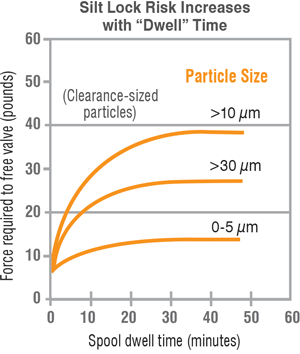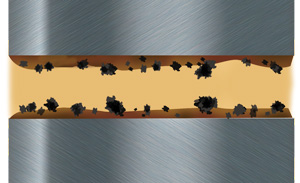Recognizing the Causes and Hazards of Silt Lock
Do you know about silt lock? This common condition causes motion impediment failure in certain machines. While this type of failure usually doesn’t involve wear or permanent internal damage to the machine, it is sudden and abrupt. Silt lock is the result of solid contamination and is amplified by other conditions that must be controlled where possible. It is most often associated with hydraulic systems and produces seizure or jamming of components.
Because of its lack of warning or predictability, silt lock is responsible for some of the most devastating and destructive catastrophes in mechanical machinery. These include mechanical casualties, prolonged production losses and even loss of human life. Silt lock has been found to be the root cause of countless failures related to aircraft, spacecraft, passenger cars, elevators, turbine generators, tower cranes, etc.
Obliteration-Prone Electrohydraulic Valves
Electrohydraulic valves are used extensively in modern hydraulic systems. They couple the immediate response of electrical control with the high power of hydraulics. In other words, they rapidly convert electrical energy to powerful and responsive mechanical energy. Because the structure of these valves is generally more complicated and intricate than ordinary control valves, they are less tolerant to solid contamination.
 Typical examples of such valves include solenoid, pulse-width modulated (PWM), proportional control and servo valves. For example, electrohydraulic valves are critical to steam turbine performance and include steam throttle valves, trip solenoid valves and intercept valves. In gas turbine service, you might have an inlet guide vane valve (on peaking units) and/or a gas control valve (in base load units).
Typical examples of such valves include solenoid, pulse-width modulated (PWM), proportional control and servo valves. For example, electrohydraulic valves are critical to steam turbine performance and include steam throttle valves, trip solenoid valves and intercept valves. In gas turbine service, you might have an inlet guide vane valve (on peaking units) and/or a gas control valve (in base load units).
As shown in Figure 1, silt particles less than 10 microns can enter the clearances between the spool and bore in the leakage path. This obliteration of the clearance space can result in increasing static friction of the spool when the valve is actuated. This can cause a stick-slip movement, which is also known as a hard-over condition. Servo valves are particularly prone to this form of contaminant failure due to their high performance demands. For instance, a stick-slip of valve movement in commercial aircraft hydraulics might result in the loss of critical control during a landing sequence.
Critical Risk Factors
Particles generally don’t act alone in causing silt-induced motion impediment failures. Most often it is a team effort that increases both the magnitude and frequency of the risk. These risk factors are described below:
 Particle Size and Clearance
Particle Size and Clearance
As with contaminant wear, particle size matters. Very large particles can’t enter the working clearance and are swept aside. Very small particles pass through the clearance without restriction. However, clearance-sized particles cause the highest risk. This is seen in Figure 2 where 10-micron particles exhibited greater static friction in spool valves compared to particles that were 30 microns and 0-5 microns.
In valves, silt lock generally occurs as a result of an eccentric position of the spool as it rests in the bore. Due to the weight of the spool, the annular clearance varies from submicron in the bottom position to 10-50 microns in the space above. A single tramp particle may be all that’s needed to seed the obliteration process, as shown in Figure 1. This primary particle narrows the clearance, allowing the smaller and more highly populated secondary particles to load into the clearance space. These secondary particles are the “silt” that causes the high static friction (stick-slip or complete seizure), resulting in motion impediment failure.
Dwell Time
Many valves are in constant motion, while others remain at rest until needed. These may be governor valves in a turbine electrohydraulic control (EHC) system or landing gear hydraulic valves in commercial aircraft. When a valve remains stationary, the fluid leakage path across the silt land (the zone where silt particles pile up) is exposed to more and more particles. Given enough dwell time, the particle buildup (obliteration) is sufficient to arrest movement of the valve and cause motion impediment failure. The influence of dwell time can be observed in Figure 2.
Most aircraft valves mitigate the dwell time/obliteration risk by keeping the valve spool fluttering, a design condition called “dither.” Nonetheless, as most seasoned airline pilots will tell you, these valves are still known to stick on occasion. Television audiences were able to see an example of contaminant-induced valve stiction a few years ago on “America’s Funniest Home Videos.” A life-sized hydraulic Abraham Lincoln was shown moving erratically during a showing of Disneyworld’s Hall of Presidents.

Oil Pressure Differential
Oil is always trying to move from high to low pressure. In typical electrohydraulic valves, the annular space between the spool and the bore is all that separates high pressure from low pressure. Oil leaks through this pathway at a higher velocity with increasing operating pressures. This results in more particles being exposed to the silt lands and more packing force on the particles, causing static friction.
Water Contamination
Free and emulsified water in oil will preferentially occlude to most solid particles such as dirt. The hydrogen bonding in the water molecules causes strong attractive forces similar to the clumping of wet sand. Laboratory studies have shown that moisture sharply aggravates bird’s-nest obliteration in valves, orifices, glances and other tight-clearance flow paths.
Varnish and Sludge
Varnish is a soft, gummy deposit that collects on internal machine surfaces. It tends to be more acute on metal surfaces that are cooler than the oil. Varnish condenses on these cool surfaces, producing a sticky residue. Electrohydraulic valve surfaces are a common destination for varnish insolubles in oil. Nearby particles can get stuck on these adherent surfaces. This condition is known as the “fly paper” effect (see Figure 3). The synergistic result greatly increases the risk of silt lock and stiction.
Controlling the Silt Lock Risk
Maintenance and reliability professionals don’t have the convenient ability to redesign machinery or even change operating demands to reduce the risk of silt lock. However, they can influence the conditions to which the machine and its components are exposed. This would include controlling particle contamination (exclusion and removal), water contamination and varnish potential. With suitable diligence, not only is the risk of silt lock significantly reduced, so too is the risk of wear and corrosion mode failures.
